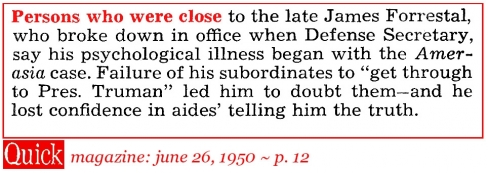It was a clear day on a fast track for James Forrestal (1892 – 1949) when the U.S. Congress passed the Two Ocean Navy Bill during the Summer of 1940. At that time, both Europe and Asia were engulfed in war and it seemed certain, to all thinking souls, that the U.S was not going to get out of it. Serving as the Under Secretary of the Navy, with Frank Knox (1874 – 1944) presiding as his senior, Forrestal was charged with the duty of building the U.S. Navy into something far more dangerous than it already was - and he did:
"[The U.S. Congress] spent ninety-four billion on it, but they got value received. In 1940 we only had three hundred and eighty-five combat ship. The last available figures show that Knox and Forrestal added nine battleships, nineteen first-line aircraft carriers, twenty cruisers, more than five hundred destroyers and destroyer escorts, more than one hundred submarines, and literally thousands of auxiliary ships, landing craft, patrol boats, mine layers and sweepers. When this team started work the Navy had a mere 2, 112 aircraft of all types. Today our Navy has 42,600 planes, more than half of which are combat aircraft."
Forrestal did his job well. In 1947, when the name of the Department of War was changed to the Department of Defense, Truman named him as its first secretary. In 1954 The U.S. Navy honored his memory by launching the U.S.S Forrestal, which was the largest aircraft carrier ever built up to that time.
Navy Secretary Frank Knox gushes over the two-ocean Navy in this article.
Read an article about the many faults of the German Navy during the Second World War...

Click here to read about Admiral Raymond Spruance.
|
